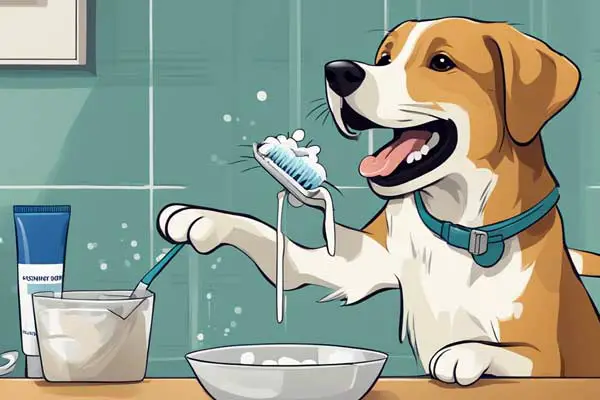Taking care of your dog’s teeth is crucial for their overall health. Like us, dogs can develop dental issues like plaque, tartar, gum disease, and bad breath.
Ignoring their dental health can lead to more severe problems, including infections affecting other parts of their body. Neglecting oral hygiene can result in the buildup of harmful bacteria in the mouth, causing dental disease.
Dogs often face dental issues, with around 80% of dogs older than three years having some type of dental problem. You can tell a dog has dental issues if they have bad breath, teeth that have changed color, gums that bleed, or difficulty eating.
To maintain your dog’s oral health and prevent dental issues, the American Veterinary Medical Association suggests brushing your dog’s teeth regularly. It’s best to aim for daily brushing, but a minimum of two to three times a week is recommended for good teeth and gum care.
Regular brushing removes plaque and bacteria from your dog’s teeth and gums, preventing tartar buildup and reducing the risk of gum disease. It also helps freshen their breath and can prevent more severe health problems caused by dental disease.
In addition to regular brushing, you must schedule regular dental checkups with your veterinarian. They can perform a thorough dental cleaning and identify any potential dental problems before they become more severe.
When to Start Brushing Your Dog’s Teeth
To make brushing your dog’s teeth easier as they age, it’s best to begin the practice when they’re just puppies. This early start will help them become accustomed to the routine.
Puppies start to develop their baby teeth at around 3 to 4 weeks old, and by the time they are six months old, they will have all their adult teeth. They must start brushing their teeth when their baby teeth come in.
Starting early will help your puppy get used to the sensation of having their teeth brushed and make it easier for you to establish a routine. It is also essential to make the experience as positive as possible by giving them lots of treats and praise during and after the brushing session.
If you own an older dog who hasn’t had their teeth brushed before, you can still establish a brushing routine. Nevertheless, it might require extra time and patience to help them get accustomed to it. Starting gradually and ensuring a positive experience is crucial to prevent them from developing a negative attitude toward tooth brushing.
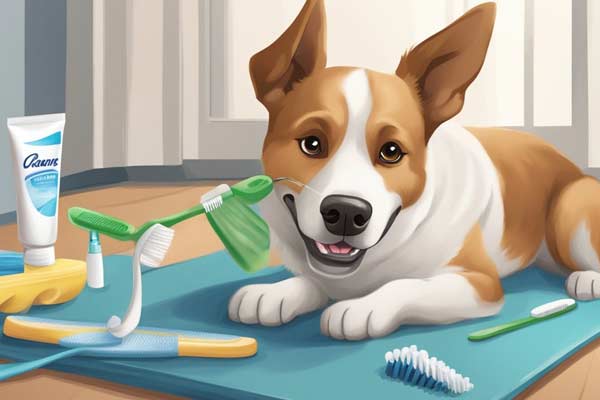
Choosing the Right Tools for Brushing
Selecting the right tools is crucial when brushing your dog’s teeth. The proper tools can simplify the process and make it more effective, while the wrong ones might cause discomfort or harm to your furry companion.
A vital tool for brushing your dog’s teeth is a specialized dog toothbrush. These toothbrushes are designed to comfortably fit in your dog’s mouth and effectively clean their teeth. They come in various sizes and shapes, so it’s essential to choose one that suits your dog’s size and breed.
When picking a dog toothbrush, pay attention to the bristles. It’s best to opt for soft bristles, which are gentle on your dog’s teeth and gums. Avoid using regular human toothbrushes, which can be too abrasive and potentially damage your dog’s mouth.
Aside from a dog toothbrush, you should also have some dog toothpaste. It’s essential to use toothpaste made specifically for dogs because regular human toothpaste can be harmful if your dog swallows it. The good news is that pet toothpaste comes in different flavors, allowing you to pick one that your furry friend will like.
Some dog owners choose natural options like baking soda instead of pet toothpaste. To do this, you can make a paste by mixing a small amount of baking soda with water and applying it to your dog’s teeth. Be cautious not to overuse baking soda as it can be too abrasive if used excessively.
Another option for brushing your dog’s teeth is a finger brush. These brushes fit over your finger and allow you to clean your dog’s teeth using your finger. Finger brushes can be a suitable choice for dogs resistant to traditional toothbrushes.
The Correct Brushing Technique
Brushing your dog’s teeth is not just about scrubbing them with a toothbrush. It is important to use the correct brushing technique to ensure that all surfaces of their teeth and gum line are properly cleaned. Here are some steps to follow:
- Select a toothbrush made for dogs, with gentle bristles and a shape tailored to fit a dog’s mouth.
- Ensure you use toothpaste specially made for dogs because regular toothpaste for humans can be dangerous if your furry friend ingests it.
- Begin by acquainting your dog with mouth handling. Slowly lift their lips and gently touch their teeth and gums with your finger.
- Once your dog is at ease with mouth handling, introduce the toothbrush. Apply a small amount of dog toothpaste to the brush and let your dog inspect and taste it.
- Hold the toothbrush at a 45-degree angle to your dog’s teeth and brush in a circular motion. Focus on the gum line and all surfaces of the teeth.
- Be patient and gentle. If your dog becomes agitated or uncomfortable, take a break and try again later.
- Finish by giving your dog a treat or reward for their cooperation.
Brushing your dog’s teeth twice a week is an intelligent practice. But if your dog often has dental problems, your vet might suggest brushing more often.
How Often to Brush Your Dog’s Teeth
Ensuring your furry friend’s oral health is crucial for their overall well-being. An essential part of their dental care is brushing their teeth. So, the big question is, how frequently should you give your dog’s teeth a good scrub?
According to experts, brushing your dog’s teeth two to three times a week is generally enough to keep their teeth clean and prevent the accumulation of plaque and tartar. However, if your dog is prone to dental issues, your vet might recommend a more frequent brushing schedule.
It’s crucial to establish a consistent teeth-brushing routine for your dog as it helps ward off harmful bacteria in their mouth. This routine also aids in preventing issues like bad breath, gum disease, and tooth decay.
When starting this brushing routine, it’s essential to use toothbrushes and toothpaste made specifically for dogs. Regular human toothpaste can harm dogs due to its potentially toxic ingredients.
To make the teeth-brushing experience more comfortable for your dog, introduce them slowly to the toothbrush and toothpaste. Let them get accustomed to the taste and texture by allowing them to sniff these items.
When brushing your dog’s teeth, concentrate on the outer surfaces of their teeth, where most plaque and tartar tend to accumulate. Utilize gentle circular motions while brushing, with special attention to the back molars.
Potential Dental Problems in Dogs
Many dogs frequently encounter dental issues, which, if ignored, can result in severe health problems. Here are some of the typical dental issues that dogs may suffer from:
Plaque and Tartar Buildup
Plaque is like a sticky film of germs on your teeth. If you don’t clean it off, it can become hard tartar, making your gums and teeth sick. Brushing your teeth regularly can keep plaque and tartar away.
Gum Disease
Gum disease, or periodontal disease, arises when the accumulation of plaque and tartar on teeth goes unaddressed. If you don’t take care of it, you might end up with redness and puffiness, and, in bad cases, your teeth could fall out.
Tooth Decay
Dogs can develop tooth decay when harmful bacteria break down their tooth enamel. This can result in pain, infection, and, if not addressed, eventual tooth loss.
Gingivitis
Gingivitis occurs when your gums become inflamed, turning red, swelling, and bleeding, often due to plaque buildup.
Infection
Bacteria, viruses, or fungi can trigger infections in the mouth. These microorganisms can result in discomfort and inflammation and, if ignored, may escalate into more severe health complications.
To avoid these oral health issues in dogs, maintaining a routine dental care regimen, such as regular brushing, is crucial. Additionally, scheduling periodic checkups with a veterinarian is vital.
These checkups can help detect any potential problems in their early stages and prevent them from evolving into more severe conditions.
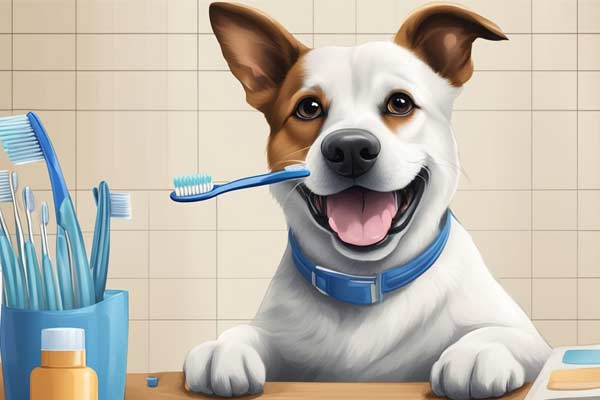
Professional Dental Care for Dogs
Maintaining your dog’s dental health involves two key components: regular at-home care and professional dental cleanings. While brushing and taking care of your dog’s teeth at home is essential, it’s also crucial to have your veterinarian perform a dental cleaning.
Before the cleaning, your veterinarian will conduct a comprehensive oral examination, which may include X-rays to uncover any hidden dental problems.
They will also perform pre-anesthetic blood work to confirm that your dog is healthy and can safely undergo anesthesia. During the cleaning procedure, your dog will be under anesthesia to ensure their safety and comfort.
Professional dental cleanings are typically performed by a veterinary dental specialist or a veterinarian with specialized training in dental care.
The procedure involves scaling and polishing the teeth, as well as cleaning under the gum line to remove any tartar buildup. The teeth will also be examined for any signs of damage or decay.
Professional dental cleanings for your dog can be pricey, but they are essential for keeping your dog’s teeth in good shape. The cost can vary depending on how much cleaning your dog needs and where you go to the vet.
The Veterinary Oral Health Council (VOHC) is a group that tests dental products made for dogs and cats. They give their seal of approval to products that do an excellent job of preventing plaque and tartar.
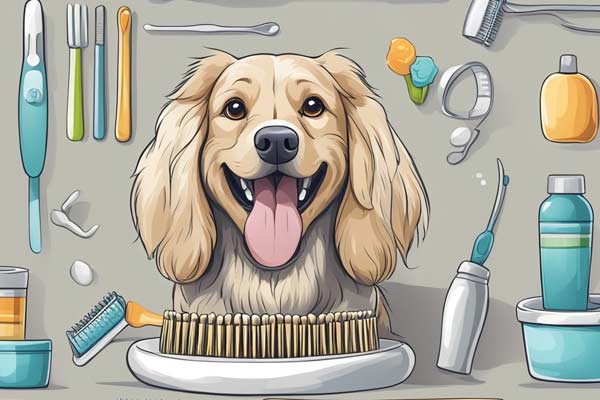
Alternative Dental Care Options
While brushing your dog’s teeth is the most effective way to maintain their dental health, it may only sometimes be possible or feasible. Fortunately, there are other dental care choices for your dog that can maintain their teeth’s cleanliness and overall health.
Dental Chews
A lot of people who have pets find dental chews more convenient for keeping their dog’s teeth clean compared to brushing their dog’s teeth frequently. Dental chews reduce plaque and tartar buildup when your dog chews on them.
Moreover, these chews often include breath-freshening and dental health-promoting ingredients.
Nevertheless, it’s essential to select dental chews that suit your dog’s size and chewing behavior. Providing a chew that’s too small might pose a choking risk, while one that’s excessively hard can harm their teeth.
Dental Treats
You might also consider using dental treats to maintain your dog’s oral health. These treats function similarly to dental chews, as they help remove plaque and tartar while your dog enjoys chewing on them.
The difference is that dental treats are generally softer and easier to chew than dental chews. This makes them an excellent choice for dogs with dental problems or those who are older and have sensitive teeth.
Just like with dental chews, it’s crucial to select dental treats that match your dog’s size and chewing habits. Additionally, remember to give them in moderation because they can be calorie-rich and lead to weight gain if given too frequently.
Dog Chews
Dog chews are another alternative dental care option for pet owners. These chews are typically made from natural materials like rawhide, bones, or antlers and are designed to provide your dog with something to chew on while also helping to clean their teeth.
However, it’s important to choose dog chews appropriate for your dog’s size and chewing habits. Giving your dog a chew that is too small can be a choking hazard while giving them a chew that is too hard can damage their teeth.

Common Mistakes to Avoid
In maintaining your dog’s dental health, avoiding common mistakes is critical to ensuring a comfortable and effective teeth-cleaning process for you and your furry companion.
First and foremost, never use human toothpaste on your dog’s teeth. Human toothpaste contains harmful ingredients like xylitol, which can be toxic for dogs, leading to low blood sugar and liver problems. Instead, opt for toothpaste specifically designed for dogs.
Another pitfall to dodge is excessive brushing force, which can cause discomfort and bleeding. Employ a gentle touch and cease brushing if you notice any bleeding or signs of discomfort.
To make the experience more pleasant for your dog, choose a soft-bristled toothbrush and start with brief, gentle brushing sessions. Gradually extend the duration as your dog becomes more accustomed to the process.
Finally, make sure you regularly take care of your dog’s toothbrush. If it starts to look worn out or frayed, replace it. This routine will keep bacteria from accumulating and prevent unpleasant odors from forming on the brush.
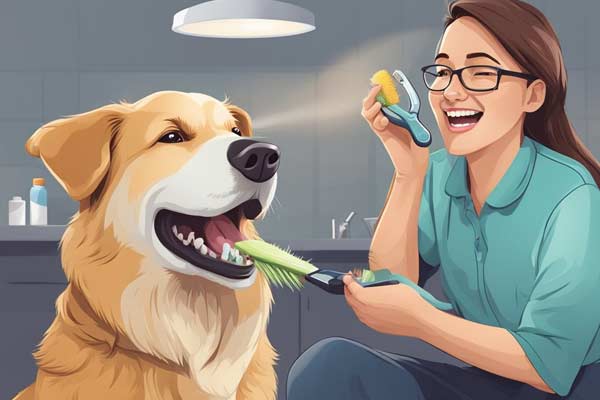
The Role of Diet and Breed in Dental Health
Dental health in dogs is not only about brushing their teeth regularly. What they eat and their breed can also play a significant role in maintaining their dental health.
Certain breeds are more prone to dental disease than others. For example, smaller breeds, such as Chihuahuas and Yorkshire Terriers, are more susceptible to dental problems due to their smaller mouths and teeth.
On the other hand, breeds like Bulldogs and Pugs, which have shorter snouts, tend to experience more dental problems because of the shape of their mouths.
What your dog eats can affect their teeth. If they eat a lot of carbs and sugary stuff, it can make plaque and tartar build up, causing dental issues.
To prevent these issues, it’s advisable to provide dogs with a diet high in protein and low in carbohydrates. Furthermore, giving them hard, crunchy foods can naturally assist in keeping their teeth clean.
It is essential to note that dental disease can affect any breed, regardless of their diet and size. Therefore, it is crucial to monitor your dog’s dental health and take them to the vet for regular checkups.
Final Thoughts for the Pet Parent
Responsible pet ownership involves ensuring your dog’s dental health is well-maintained.
Maintaining your dog’s oral hygiene is vital in preventing dental problems like periodontal disease, which can ultimately lead to tooth loss and various health concerns.
While the American Veterinary Medical Association recommends daily brushing, it may only be feasible for some pet parents. However, aiming for at least two to three times a week can still make a significant difference in your dog’s oral health.
In addition to brushing, there are other steps you can take to maintain your dog’s dental hygiene. Chew toys and dental treats can help reduce plaque buildup, while regular checkups with your veterinarian can catch any dental issues early on.
It is important to note that if your dog shows signs of dental issues such as bad breath, bleeding gums, or difficulty eating, you should seek veterinary care immediately.
